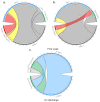SARS-CoV-2 Renal Impairment in Critical Care: An Observational Study of 42 Cases (Kidney COVID)
- PMID: 33917886
- PMCID: PMC8068224
- DOI: 10.3390/jcm10081571
SARS-CoV-2 Renal Impairment in Critical Care: An Observational Study of 42 Cases (Kidney COVID)
Abstract
The severe acute respiratory syndrome coronavirus 2 (SARS-CoV-2) infection leads to 5% to 16% hospitalization in intensive care units (ICU) and is associated with 23% to 75% of kidney impairments, including acute kidney injury (AKI). The current work aims to precisely characterize the renal impairment associated to SARS-CoV-2 in ICU patients. Forty-two patients consecutively admitted to the ICU of a French university hospital who tested positive for SARS-CoV-2 between 25 March 2020, and 29 April 2020, were included and classified in categories according to their renal function. Complete renal profiles and evolution during ICU stay were fully characterized in 34 patients. Univariate analyses were performed to determine risk factors associated with AKI. In a second step, we conducted a logistic regression model with inverse probability of treatment weighting (IPTW) analyses to assess major comorbidities as predictors of AKI. Thirty-two patients (94.1%) met diagnostic criteria for intrinsic renal injury with a mixed pattern of tubular and glomerular injuries within the first week of ICU admission, which lasted upon discharge. During their ICU stay, 24 patients (57.1%) presented AKI which was associated with increased mortality (p = 0.007), hemodynamic failure (p = 0.022), and more altered clearance at hospital discharge (p = 0.001). AKI occurrence was associated with lower pH (p = 0.024), higher PaCO2 (CO2 partial pressure in the arterial blood) (p = 0.027), PEEP (positive end-expiratory pressure) (p = 0.027), procalcitonin (p = 0.015), and CRP (C-reactive protein) (p = 0.045) on ICU admission. AKI was found to be independently associated with chronic kidney disease (adjusted OR (odd ratio) 5.97 (2.1-19.69), p = 0.00149). Critical SARS-CoV-2 infection is associated with persistent intrinsic renal injury and AKI, which is a risk factor of mortality. Mechanical ventilation settings seem to be a critical factor of kidney impairment.
Keywords: SARS-CoV-2; acute kidney injury; intrinsic renal injury; pneumonia; proteinuria.
Conflict of interest statement
The authors declare no conflict of interest.
Figures

Similar articles
-
Risk of acute kidney injury in critically-ill patients with COVID-19 compared with seasonal influenza: a retrospective cohort study.EClinicalMedicine. 2024 Mar 14;70:102535. doi: 10.1016/j.eclinm.2024.102535. eCollection 2024 Apr. EClinicalMedicine. 2024. PMID: 38516106 Free PMC article.
-
Severe Acute Kidney Injury in Critically Ill Patients with COVID-19 Admitted to ICU: Incidence, Risk Factors, and Outcomes.J Clin Med. 2021 Mar 15;10(6):1217. doi: 10.3390/jcm10061217. J Clin Med. 2021. PMID: 33804100 Free PMC article.
-
Acute Kidney Injury in COVID-19 Patients: An Inner City Hospital Experience and Policy Implications.Am J Nephrol. 2020;51(10):786-796. doi: 10.1159/000511160. Epub 2020 Oct 2. Am J Nephrol. 2020. PMID: 33011717 Free PMC article.
-
Acute kidney injury in burn patients admitted to the intensive care unit: a systematic review and meta-analysis.Crit Care. 2020 Jan 2;24(1):2. doi: 10.1186/s13054-019-2710-4. Crit Care. 2020. PMID: 31898523 Free PMC article.
-
Perfusion deficits may underlie lung and kidney injury in severe COVID-19 disease: insights from a multicenter international cohort study.J Anesth Analg Crit Care. 2024 Jul 6;4(1):40. doi: 10.1186/s44158-024-00175-1. J Anesth Analg Crit Care. 2024. PMID: 38971842 Free PMC article. Review.
Cited by
-
Predictive Ability of Procalcitonin for Acute Kidney Injury: A Narrative Review Focusing on the Interference of Infection.Int J Mol Sci. 2021 Jun 27;22(13):6903. doi: 10.3390/ijms22136903. Int J Mol Sci. 2021. PMID: 34199069 Free PMC article. Review.
-
COVID-19 coagulopathies: Human blood proteins mimic SARS-CoV-2 virus, vaccine proteins and bacterial co-infections inducing autoimmunity: Combinations of bacteria and SARS-CoV-2 synergize to induce autoantibodies targeting cardiolipin, cardiolipin-binding proteins, platelet factor 4, prothrombin, and coagulation factors.Bioessays. 2021 Dec;43(12):e2100158. doi: 10.1002/bies.202100158. Epub 2021 Oct 22. Bioessays. 2021. PMID: 34677872 Free PMC article.
-
Differences between COVID-19-induced acute kidney injury and chronic kidney disease patients.J Bras Nefrol. 2022 Apr-Jun;44(2):155-163. doi: 10.1590/2175-8239-JBN-2021-0161. J Bras Nefrol. 2022. PMID: 35258071 Free PMC article.
-
No sex differences in the incidence, risk factors and clinical impact of acute kidney injury in critically ill patients with sepsis.Front Immunol. 2022 Jul 14;13:895018. doi: 10.3389/fimmu.2022.895018. eCollection 2022. Front Immunol. 2022. PMID: 35911764 Free PMC article.
-
Continuous High Positive-End Expiratory Pressure May Worsen Renal Function in Patients With Acute Respiratory Distress Syndrome: Retrospective Analyses of a Nationwide, Multicenter Observational Study in Japan.Cureus. 2023 Feb 20;15(2):e35233. doi: 10.7759/cureus.35233. eCollection 2023 Feb. Cureus. 2023. PMID: 36968897 Free PMC article.
References
-
- Phua J., Weng L., Ling L., Egi M., Lim C.M., Divatia J.V., Shrestha B.R., Arabi Y.M., Ng J., Gomersall C.D., et al. Intensive care management of coronavirus disease 2019 (COVID-19): Challenges and recommendations. Lancet Respir. Med. 2020;8:506–517. doi: 10.1016/S2213-2600(20)30161-2. - DOI - PMC - PubMed
-
- Wu Z., McGoogan J.M. Characteristics of and Important Lessons from the Coronavirus Disease 2019 (COVID-19) Outbreak in China: Summary of a Report of 72314 Cases from the Chinese Center for Disease Control and Prevention. JAMA-J. Am. Med. Assoc. 2020;323:1239–1242. doi: 10.1001/jama.2020.2648. - DOI - PubMed
LinkOut - more resources
Full Text Sources
Other Literature Sources
Research Materials
Miscellaneous

